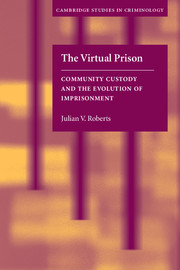Book contents
- Frontmatter
- Contents
- List of figures and tables
- Foreword by Andrew Ashworth
- Preface
- 1 Introduction to the concept of community custody
- 2 The way we punish now
- 3 Conceptualizing community custody
- 4 Representative models of community custody
- 5 Coming home to prison: offender perceptions and experiences
- 6 The effect of community custody on prison admissions
- 7 Public attitudes to community custody
- 8 Making community custody sentences work
- Notes
- References
- Index
2 - The way we punish now
Published online by Cambridge University Press: 07 December 2009
- Frontmatter
- Contents
- List of figures and tables
- Foreword by Andrew Ashworth
- Preface
- 1 Introduction to the concept of community custody
- 2 The way we punish now
- 3 Conceptualizing community custody
- 4 Representative models of community custody
- 5 Coming home to prison: offender perceptions and experiences
- 6 The effect of community custody on prison admissions
- 7 Public attitudes to community custody
- 8 Making community custody sentences work
- Notes
- References
- Index
Summary
Despite the proliferation of alternatives to incarceration over the past two decades, and the decline in reported crime in many Western nations during the 1990s – which might have relieved some of the pressure on politicians and sentencers to ‘do something about crime’ – custody continues to be widely used as a sanction. In fact, over the past decade, there has been little change in the proportionate use of prison as a sanction in many countries. This chapter reviews trends with respect to the use of imprisonment over the past decade. No attempt is made to summarize statistics from all jurisdictions, but rather to highlight common trends. These data document the problem to which community custody is a response. They reveal the resilience of the prison as a penal sanction and the relative failure of alternatives to displace imprisonment as a punishment even for less serious categories of offending. The analysis then focuses on the sentences of imprisonment that are most likely to be replaced by a community custody sanction. As well, the chapter summarizes findings from the International Crime Victimization Survey; these data demonstrate that there is considerable variability in the extent of public acceptance of alternatives to custody. This variation is important because it places the rates of custody in some context, and suggests that a high use of incarceration is not an immutable reality.
- Type
- Chapter
- Information
- The Virtual PrisonCommunity Custody and the Evolution of Imprisonment, pp. 22 - 37Publisher: Cambridge University PressPrint publication year: 2004



